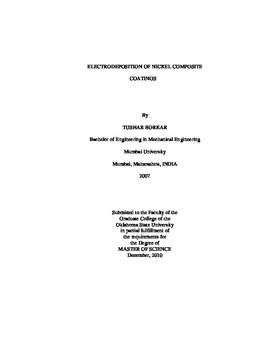| dc.contributor.advisor | Harimkar, Sandip P. | |
| dc.contributor.author | Borkar, Tushar | |
| dc.date.accessioned | 2014-04-17T19:52:06Z | |
| dc.date.available | 2014-04-17T19:52:06Z | |
| dc.date.issued | 2010-12-01 | |
| dc.identifier.uri | https://hdl.handle.net/11244/9905 | |
| dc.description.abstract | Pulse electrodeposition (PC) and pulse reverse electrodeposition (PRC) bring a new era in improving the surface properties of metals. These processes are associated with many advantages, such as reduction in porosity, low level of inclusions, and higher deposition rates compared to direct current (DC) electrodeposition process. There is much more flexibility in varying three basic parameters which are, pulse current density, on time, and off time in pulse electrodeposition resulting in unique composition and microstructure of coating being deposited. In this work, nickel matrix composite coatings were synthesized by co-depositing nano particles (Al2O3, SiC, and ZrO2) from Watts bath. To get detailed insight into effect of processing parameters on the microstructure, mechanical, and tribological properties of the composite coatings, the coatings were also fabricated using DC, PC, and PRC techniques. Also, the effect of bath loading on the level of reinforcement in the coating was investigated for Ni-Al2O3 composite coatings. Furthermore an attempt was made to produce Ni-CNT coatings by pulse electrodeposition method. Pure nickel coatings were also prepared for comparison. Composite coatings deposited using PC and PRC techniques exhibited significant improvement in microhardness and wear resistance. The presence of nanoparticles in the composite coating seems to prohibit the columnar growth of the nickel grains resulting in random/weak texture and smaller thickness of the composite coatings. Ni-Al2O3 composite coatings show maximum hardness and wear resistance compared to Ni-SiC and Ni-ZrO2 composite coatings. As Al2O3 content in electroplating bath increases, Microhardness and wear resistance of composite coatings increases but thickness of the coatings decreases due to nanoparticles obstructing grain growth. The Ni-CNT composite coatings exhibited significantly improved microhardness compared to pure nickel coatings. | |
| dc.format | application/pdf | |
| dc.language | en_US | |
| dc.publisher | Oklahoma State University | |
| dc.rights | Copyright is held by the author who has granted the Oklahoma State University Library the non-exclusive right to share this material in its institutional repository. Contact Digital Library Services at lib-dls@okstate.edu or 405-744-9161 for the permission policy on the use, reproduction or distribution of this material. | |
| dc.title | Electrodeposition of Nickel Composite Coatings | |
| dc.type | text | |
| dc.contributor.committeeMember | Hanan, Jay C. | |
| dc.contributor.committeeMember | Singh, Raman P. | |
| osu.filename | Borkar_okstate_0664M_11127.pdf | |
| osu.college | Engineering, Architecture, and Technology | |
| osu.accesstype | Open Access | |
| dc.description.department | Mechanical & Aerospace Engineering | |
| dc.type.genre | Thesis | |
| dc.subject.keywords | composite coatings | |
| dc.subject.keywords | electrodeposition | |
| dc.subject.keywords | microhardness | |
| dc.subject.keywords | surface roughness | |
| dc.subject.keywords | wear resistance | |
| dc.subject.keywords | x-ray diffraction | |
